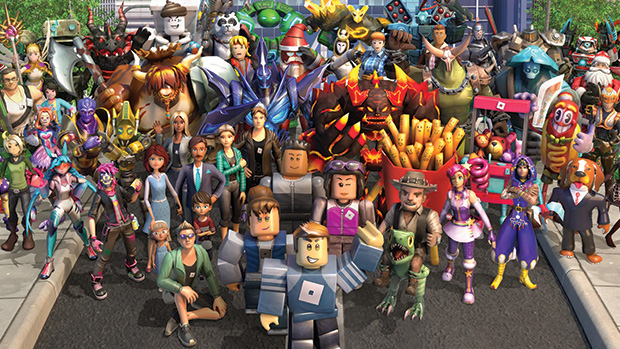Why it's time to listen to the social storytellers
With new TV shows often going undiscovered by audiences whose attention is more divided than ever, launching fledgling IP on social platforms such as Roblox, TikTok and YouTube could be the key to finding relevance in a fragmented digital landscape.

Kids live in a Roblox world they can easily manipulate
It never hurts to pay particular attention to the children’s media sector. Many of the problems it has faced, such as its viewers deserting linear TV for on-demand in the 2010s, are ones that inevitably rock the wider industry a few years later.
‘Social storytelling’ is a term that is spoken about more and more in children’s media in response to its audience’s overwhelming preference for online game platforms such as Roblox and Minecraft over traditional TV.
As delegates at Content London 2023 heard from Chad Nelson, a consultant for Open AI and creator of the artificial intelligence-generated short film Critterz: “The younger generation live in a Roblox/Minecraft world and think of entertainment as a sandbox that everyone should be able to manipulate and play with.”
Although talk about the metaverse has died down considerably since 2022, it’s clear anyone targeting a youth demographic has to develop with social platforms in mind rather than committing all their funds to a traditional 26×11’ or 6×30’ series.
“Social storytelling is a great way to extend narratives across multiple channels to reach younger audiences, creating a transmedia flywheel that is emerging as an alternative way to build IP at a time when streamers and broadcasters are largely closed for business,” says Jo Redfern, MD at Wind Sun Sky Entertainment.
The Vancouver-based company is on board an episodic scripted series based on the Roblox platform game Creatures of Sonaria, having already made the first-ever animated series produced fully on the platform, with Twilight Daycare: The Show!.
An ideal-case scenario for social storytelling would see, for example, a shortform animated IP made available on social platforms like Roblox and YouTube to allow young audiences to shape the story themselves.
“It encourages direct interaction between creators and the audience. It allows for real-time feedback, and that can be valuable in informing the future direction of the narrative,” adds Redfern.

Wind Sun Sky Entertainment’s Twilight Daycare: The Show!
Moreover, the doors are not closed to broadcasters, as long as they’re open to a flexible approach to launching programming.
“If a broadcaster can maximise engagement over just watching, they’re more likely to drive the social storytelling audience back to their platform. Engaging snippets that leave viewers curious can serve as an effective traffic driver. By strategically intertwining social storytelling with a broadcast or subscription-based model, traditional networks might attract a new audience by using social storytelling strategies,” says Redfern.
David Levine spent 16 years at The Walt Disney Company, leaving in 2020, a few months before the media giant’s linear TV channels Disney Channel, Disney Junior and Disney XD were axed in the UK as the Mouse House went all-in on Disney+. He then spent time at Blippi and CoComelon producer Moonbug before setting up his own company, Lightboat Media.
The firm recently consulted with the producer of an animated series that has become popular on YouTube. To deepen engagement with viewers, as well as entice traditional broadcasters towards the IP and a potential new series, Lightboat developed a digital-first shortform series based on the property.
Working with the original creators and using a lower-cost studio to replicate the original 2D designs, it drew heavily on viewer data to understand which characters, storylines and set-ups would resonate best on YouTube, giving the new series a better chance to succeed.
So what advice would Levine give to broadcasters and networks looking to get involved in social storytelling?
“It’s not just clips; the content needs to fit the platform. It doesn’t need to be the fully blown iteration of the IP, honing the content to the core characters, relationships and set-up to start,” says the exec.
“Tap into producers and creators that know the platforms and understand how to make content for those platforms. Even if the final product is envisioned to be CG, start out with lower-cost 2D; as the IP moves up the ‘food chain’ the format can evolve. Great examples of this are Moonbug’s Gecko’s Garage and Morphle.”
Meanwhile, an eight-hour saga of a marriage gone wrong, titled Who TF Did I Marry?, may sound like something you see while scrolling through the Netflix carousel, but it was actually uploaded in 50×5’-10’ episodes on TikTok by creator ReesaTeesa in February.
Teesa became an overnight internet celebrity, capturing the attention of millions with her tale of a toxic relationship while highlighting the power of bitesized social storytelling. Meanwhile, Chinese shortform scripted platform Reelshort seems to be succeeding where Quibi failed by adding gamification elements and rewards for watching.
“Young people haven’t got shorter attention spans, they’ve just got shorter interest spans,” says Redfern.
With this in mind, in New Zealand, writer and video games and interactive experiences director Alexander Swords is hosting an introduction to ‘narrative design’ in Auckland in April.
Narrative design is described as the process of understanding a story as a system to allow storytellers to better connect to both play and interactivity, for games, extended reality and live choice-driven experiences. It also gives a look ‘under the hood’ at how story functions on a meta and micro structural level, which can help linear storytelling move away from rigid conventions.
So prepare to see ‘narrative designer’ or ‘social storyteller’ on a few more (digital) business cards in the years ahead.
 Mark Loughney, senior consultant, Hub Entertainment Research
Mark Loughney, senior consultant, Hub Entertainment Research
There’s no doubt that younger viewers are not as devoted to traditional TV and movies as previous generations have been. This presents one more challenge to legacy media companies as they navigate the future of the video ecosystem. It would be futile for them to try to claw back time from non-traditional platforms, so instead media companies should look to social media as opportunities to reach GenZ with premium content.
 Evan Shapiro, media universe cartographer
Evan Shapiro, media universe cartographer
We’re in a magic moment when the creator-led community, the community economy, is going to wind up being the most important part of the content ecosystem. The most important, diverse, inclusive, representative and inventive stories are going to come from artists using technology to empower themselves. There have never been better tools to compete with the studio system, which is limping. They are in danger and a lot of them won’t be here in five years.
 Todd Lichten, head of entertainment partnerships, Roblox
Todd Lichten, head of entertainment partnerships, Roblox
It’s clear that the Kung Fu Panda franchise has found a perfect home on Roblox, but success on a competitive UGC [user-generated content] platform requires more than just a beloved IP. Props to Universal Pictures’ digital marketing and media teams for their innovative approach to delighting discerning fans – and to Sawhorse Interactive for crafting a compelling two-player obby [obstacle course] that’s set a new bar for theatrical marketing on the platform. So much other great work is coming from entertainment in the next few months on Roblox.

Jo Redfern, MD, Wind Sun Sky Entertainment
Consider a scenario where a YouTube animated series introduces characters and plotlines that seamlessly transition into a Roblox experience. Kids then contribute to the narrative with their activities in-game. With good monitoring, this could help inform subsequent storytelling by informing writers which characters, vehicles, animals and scenarios are engaged with most within the game. Then they could be up-weighted in subsequent episodes.
 Rob Doherty, media executive and consultant
Rob Doherty, media executive and consultant
Our audience is no longer where it used to be, nor as passive, and we are struggling to reach it with traditionally executed content. The new generations of audiences are better informed, better equipped and far more in control of what they want. Not only that but in their social virtual universes they can now create their own content more easily than ever before. Engaging them in new ways, through social storytelling and other means, should be the primary focus of the industry right now.
 David Levine, founder and consultant, Lightboat Media
David Levine, founder and consultant, Lightboat Media
Developing brand new IP has never been more challenging, and creating a digital-first iteration of the idea/concept/IP as a way to build awareness for it is clearly a way to lower the risk involved. Given the low RPM [revenue per mille, representing how much money is earned per 1,000 video views] for YouTube kids content, finding a way to create an all-audience IP, appealing to a broader advertiser set with higher RPM, as a backdoor pilot for a kids IP, would be an interesting way to go. The cost to enter into Roblox is lower than the YouTube/animated series route, with faster ways to generate views, but it’s challenging as a recoupment model.










 Mark Loughney, senior consultant, Hub Entertainment Research
Mark Loughney, senior consultant, Hub Entertainment Research Evan Shapiro, media universe cartographer
Evan Shapiro, media universe cartographer Todd Lichten, head of entertainment partnerships, Roblox
Todd Lichten, head of entertainment partnerships, Roblox
 Rob Doherty, media executive and consultant
Rob Doherty, media executive and consultant David Levine, founder and consultant, Lightboat Media
David Levine, founder and consultant, Lightboat Media





























